Abstract
The NZB mouse strain is genetically predisposed to develop, at approximately 6 months of age, a spontaneous and severe autoimmune anaemia caused by the production of pathogenic anti-mouse red blood cell (MRBC) autoantibodies. Although it is believed that the predisposition to autoimmune anaemia is multigenic in nature, the main pathogenic mechanism is attributed to anti-MRBC autoantibodies. We have generated eight anti-MRBC monoclonal antibody (mAb)-producing hybridomas derived from splenocytes of 9- and 12-month-old NZB mice with spontaneous autoimmune anaemia to dissect the molecular and cellular mechanisms resulting in the production of these pathogenic antibodies. The predominant immunoglobulin isotype was IgG2a, produced by five out of eight hybridomas (63%), while IgM, IgG1 and IgG2b were each produced by one hybridoma cell line (12%). Antigen specificity analysis of all eight hybridomas revealed that antibodies from seven out of eight hybridomas were monospecific for MRBC antigen(s). Only one hybridoma (clone 4-16-1) cross-reacted with rat RBC. None of the hybridomas produced antibodies reactive with single- or double-stranded DNA (ss- or dsDNA). Surface and cytoplasmic staining for the CD5 antigen revealed that none of the hybridomas was derived from CD5+ B lymphocytes. All hybridomas cause anaemia when implanted intraperitoneally into normal BALB/c mice. Molecular studies of five of the eight anti-MRBC mAb reveal that all use functionally rearranged genes from the VH J558 gene family. Three of these five mAb used FL16.1 DH genes while one had a CDR3 that resulted from a fusion between two DH genes (SP2.3 and SP2.2) from the SP family.
Full text
PDF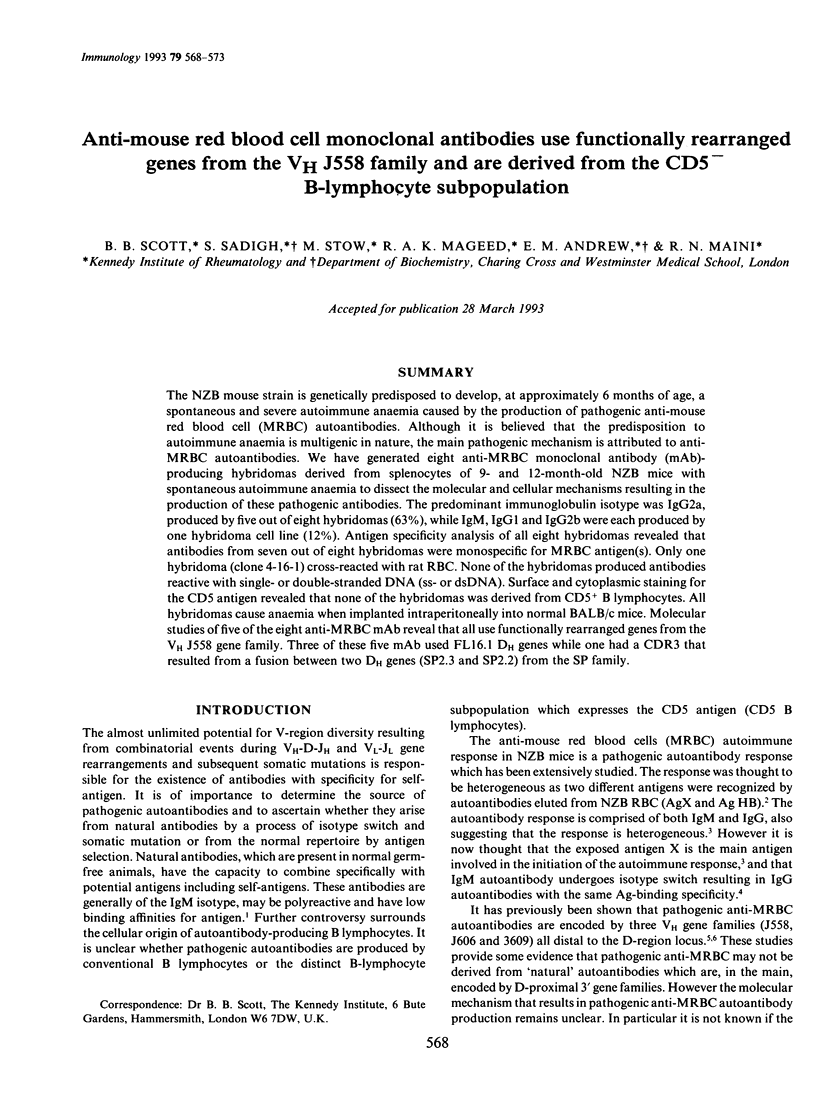
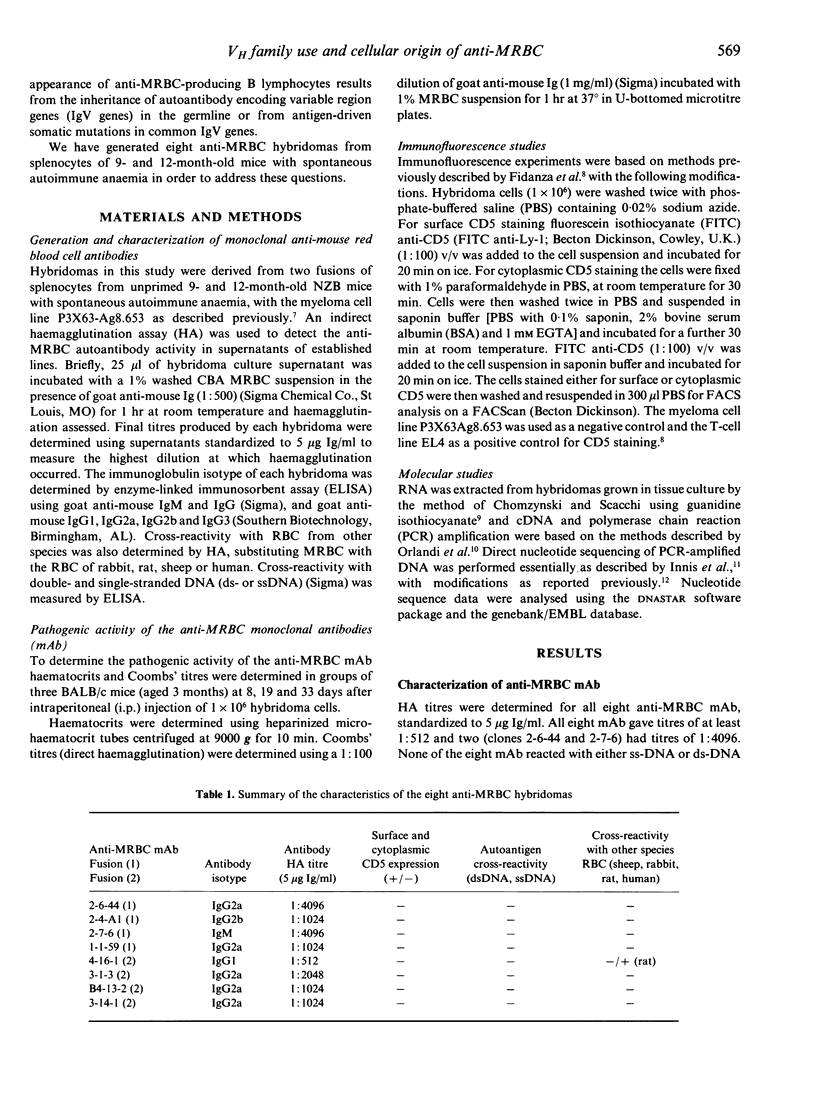
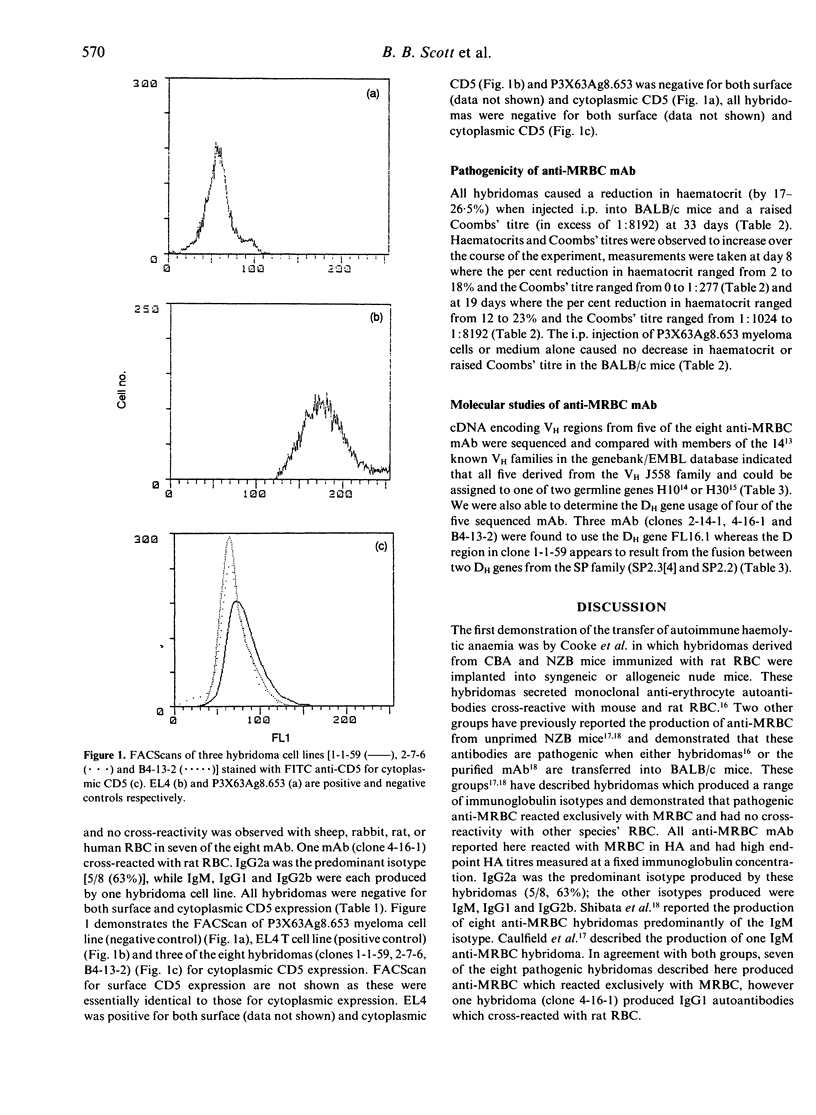
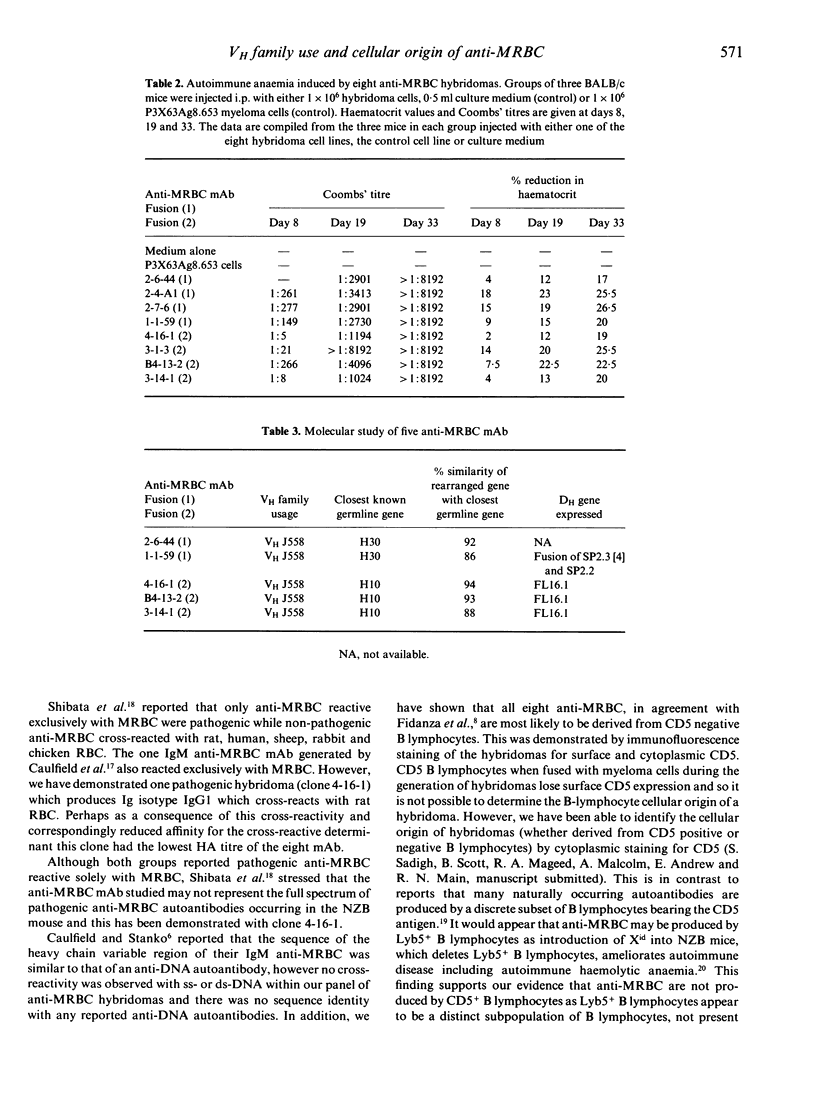
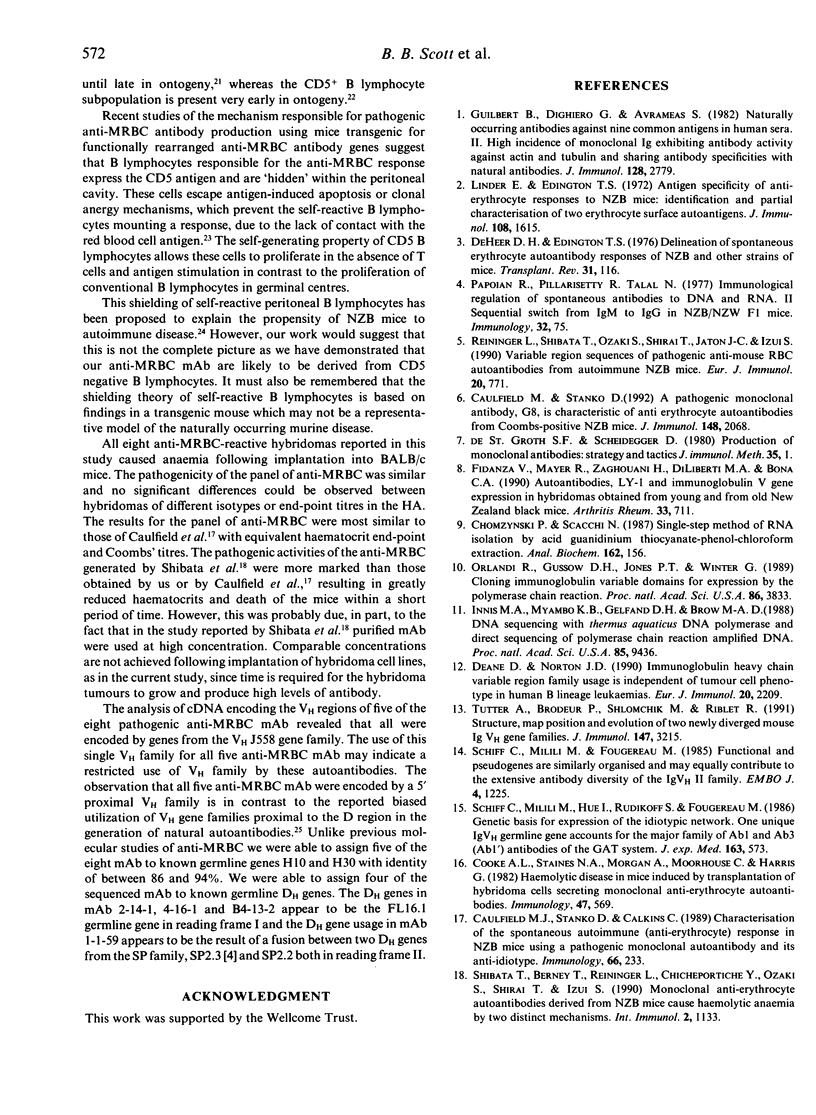
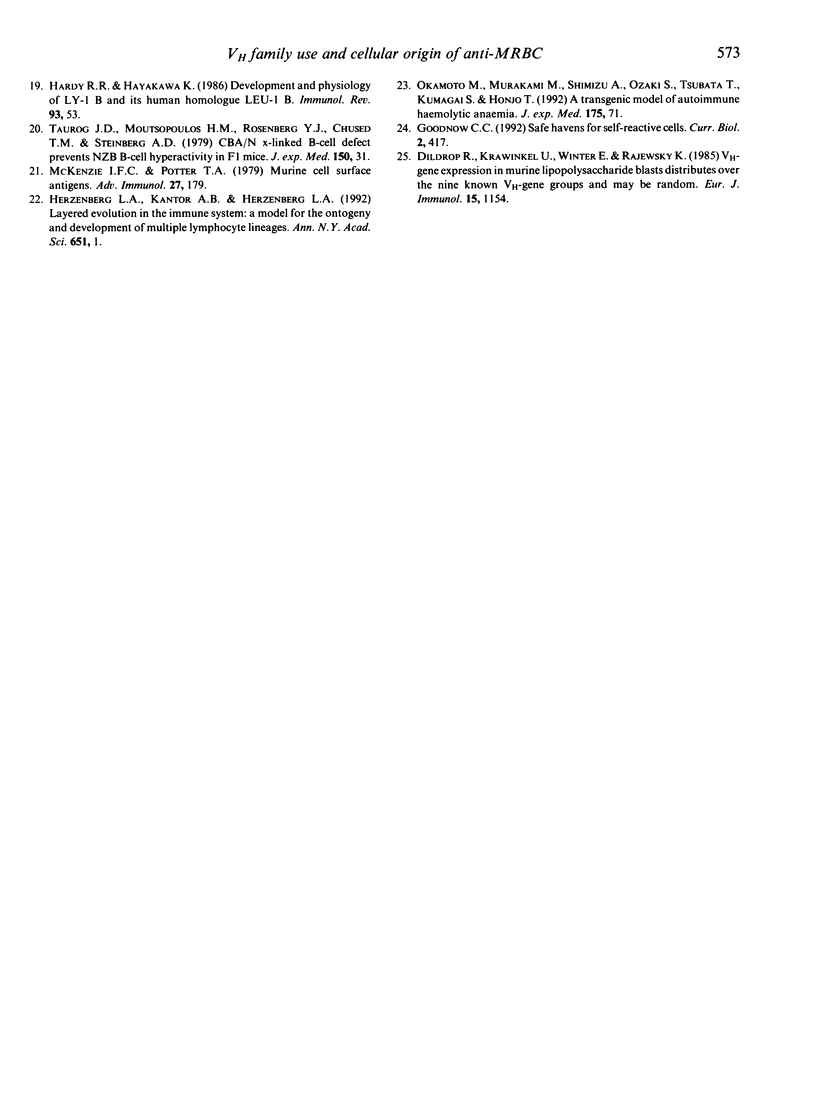
Selected References
These references are in PubMed. This may not be the complete list of references from this article.
- Caulfield M. J., Stanko D. A pathogenic monoclonal antibody, G8, is characteristic of antierythrocyte autoantibodies from Coombs'-positive NZB mice. J Immunol. 1992 Apr 1;148(7):2068–2073. [PubMed] [Google Scholar]
- Caulfield M. J., Stanko D., Calkins C. Characterization of the spontaneous autoimmune (anti-erythrocyte) response in NZB mice using a pathogenic monoclonal autoantibody and its anti-idiotype. Immunology. 1989 Feb;66(2):233–237. [PMC free article] [PubMed] [Google Scholar]
- Chomczynski P., Sacchi N. Single-step method of RNA isolation by acid guanidinium thiocyanate-phenol-chloroform extraction. Anal Biochem. 1987 Apr;162(1):156–159. doi: 10.1006/abio.1987.9999. [DOI] [PubMed] [Google Scholar]
- Cooke L. A., Staines N. A., Morgan A., Moorhouse C., Harris G. Haemolytic disease in mice induced by transplantation of hybridoma cells secreting monoclonal anti-erythrocyte autoantibodies. Immunology. 1982 Nov;47(3):569–572. [PMC free article] [PubMed] [Google Scholar]
- Deane M., Norton J. D. Immunoglobulin heavy chain variable region family usage is independent of tumor cell phenotype in human B lineage leukemias. Eur J Immunol. 1990 Oct;20(10):2209–2217. doi: 10.1002/eji.1830201009. [DOI] [PubMed] [Google Scholar]
- Deheer D. H., Edginton T. S. Cellular events associated with the immunogenesis of anti-erythrocyte autoantibody responses of NZB mice. Transplant Rev. 1976;31:116–155. doi: 10.1111/j.1600-065x.1976.tb01453.x. [DOI] [PubMed] [Google Scholar]
- Dildrop R., Krawinkel U., Winter E., Rajewsky K. VH-gene expression in murine lipopolysaccharide blasts distributes over the nine known VH-gene groups and may be random. Eur J Immunol. 1985 Nov;15(11):1154–1156. doi: 10.1002/eji.1830151117. [DOI] [PubMed] [Google Scholar]
- Goodnow C. C. Safe havens for self-reactive cells. Curr Biol. 1992 Aug;2(8):417–419. doi: 10.1016/0960-9822(92)90321-z. [DOI] [PubMed] [Google Scholar]
- Guilbert B., Dighiero G., Avrameas S. Naturally occurring antibodies against nine common antigens in human sera. I. Detection, isolation and characterization. J Immunol. 1982 Jun;128(6):2779–2787. [PubMed] [Google Scholar]
- Herzenberg L. A., Kantor A. B., Herzenberg L. A. Layered evolution in the immune system. A model for the ontogeny and development of multiple lymphocyte lineages. Ann N Y Acad Sci. 1992 May 4;651:1–9. doi: 10.1111/j.1749-6632.1992.tb24588.x. [DOI] [PubMed] [Google Scholar]
- Innis M. A., Myambo K. B., Gelfand D. H., Brow M. A. DNA sequencing with Thermus aquaticus DNA polymerase and direct sequencing of polymerase chain reaction-amplified DNA. Proc Natl Acad Sci U S A. 1988 Dec;85(24):9436–9440. doi: 10.1073/pnas.85.24.9436. [DOI] [PMC free article] [PubMed] [Google Scholar]
- McKenzie I. F., Potter T. Murine lymphocyte surface antigens. Adv Immunol. 1979;27:179–338. doi: 10.1016/s0065-2776(08)60263-1. [DOI] [PubMed] [Google Scholar]
- Orlandi R., Güssow D. H., Jones P. T., Winter G. Cloning immunoglobulin variable domains for expression by the polymerase chain reaction. Proc Natl Acad Sci U S A. 1989 May;86(10):3833–3837. doi: 10.1073/pnas.86.10.3833. [DOI] [PMC free article] [PubMed] [Google Scholar]
- Reininger L., Shibata T., Ozaki S., Shirai T., Jaton J. C., Izui S. Variable region sequences of pathogenic anti-mouse red blood cell autoantibodies from autoimmune NZB mice. Eur J Immunol. 1990 Apr;20(4):771–777. doi: 10.1002/eji.1830200410. [DOI] [PubMed] [Google Scholar]
- Schiff C., Milili M., Fougereau M. Functional and pseudogenes are similarly organized and may equally contribute to the extensive antibody diversity of the IgVHII family. EMBO J. 1985 May;4(5):1225–1230. doi: 10.1002/j.1460-2075.1985.tb03764.x. [DOI] [PMC free article] [PubMed] [Google Scholar]
- Schiff C., Milili M., Hue I., Rudikoff S., Fougereau M. Genetic basis for expression of the idiotypic network. One unique Ig VH germline gene accounts for the major family of Ab1 and Ab3 (Ab1') antibodies of the GAT system. J Exp Med. 1986 Mar 1;163(3):573–587. doi: 10.1084/jem.163.3.573. [DOI] [PMC free article] [PubMed] [Google Scholar]
- Shibata T., Berney T., Reininger L., Chicheportiche Y., Ozaki S., Shirai T., Izui S. Monoclonal anti-erythrocyte autoantibodies derived from NZB mice cause autoimmune hemolytic anemia by two distinct pathogenic mechanisms. Int Immunol. 1990;2(12):1133–1141. doi: 10.1093/intimm/2.12.1133. [DOI] [PubMed] [Google Scholar]
- Taurog J. D., Moutsopoulos H. M., Rosenberg Y. J., Chused T. M., Steinberg A. D. CBA/N X-linked B-cell defect prevents NZB B-cell hyperactivity in F1 mice. J Exp Med. 1979 Jul 1;150(1):31–43. doi: 10.1084/jem.150.1.31. [DOI] [PMC free article] [PubMed] [Google Scholar]
- Tutter A., Brodeur P., Shlomchik M., Riblet R. Structure, map position, and evolution of two newly diverged mouse Ig VH gene families. J Immunol. 1991 Nov 1;147(9):3215–3223. [PubMed] [Google Scholar]


